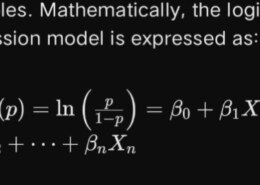What is the difference between map and set?
Logistic regression is a statistical method used for binary classification problems, where the outcome is one of two possible categories. It models the relationship between a dependent binary variable and one or more independent variables by estimating probabilities using a logistic (sigmoid) functiRead more
Logistic regression is a statistical method used for binary classification problems, where the outcome is one of two possible categories. It models the relationship between a dependent binary variable and one or more independent variables by estimating probabilities using a logistic (sigmoid) function. The output is a probability value that is mapped to one of the two possible classes using a threshold, typically 0.5.
In logistic regression, the model predicts the log-odds of the dependent variable being in a particular category. The log-odds are a linear combination of the independent variables.
Where:
– \( p \) is the probability of the dependent variable being 1.
– \( \beta_0 \) is the intercept.
– \( \beta_1, \beta_2, \ldots, \beta_n \) are the coefficients of the independent variables \( X_1, X_2, \ldots, X_n \).
Logistic regression is widely used in fields such as medicine, finance, and social sciences for tasks like disease prediction, credit scoring, and survey analysis.
See less

Both maps and sets are data structures used in programming, but they serve different purposes and have distinct characteristics: 1. Set: - Purpose: A set is used to store unique elements. - Operations: Common operations include adding elements, removing elements, and checking for the existence of elRead more
Both maps and sets are data structures used in programming, but they serve different purposes and have distinct characteristics:
1. Set:
– Purpose: A set is used to store unique elements.
– Operations: Common operations include adding elements, removing elements, and checking for the existence of elements.
– Uniqueness:Sets automatically handle duplicates, ensuring that each element is unique.
– Implementation:In many languages, sets are often implemented as hash sets, which provide average O(1) time complexity for insertion, deletion, and lookup operations.
– Use Case:Useful for tasks where you need to track a collection of unique items, like ensuring there are no duplicate values in a list.
2. Map (or Dictionary/Hash Table):
– Purpose:A map is used to store key-value pairs.
– Operations: Common operations include inserting a key-value pair, removing a key (and its associated value), and retrieving the value associated with a key.
– Keys: Keys in a map are unique, but values can be duplicated.
– Implementation: Maps are often implemented as hash tables, providing average O(1) time complexity for insertion, deletion, and lookup operations based on keys.
– Use Case:Useful for tasks where you need to associate values with keys, like looking up the meaning of a word in a dictionary.
See less